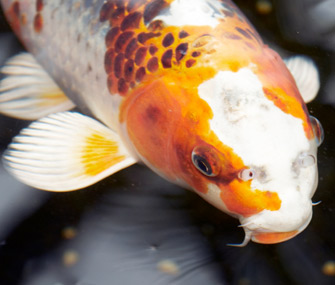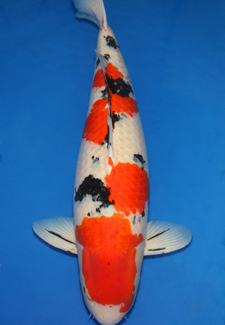Koi: Don’t Mistake These Large, Colorful Carp for Goldfish
Published on July 31, 2014

When Mike McMahon put a few fish in his backyard pond in Orlando, Florida, back in 1978, he wasn’t envisioning where he’s ended up today.
"I happened to be in a shop that had little koi, an inch and a half or 2 inches long, and I put three out in the pond," he says. "They were a lot more interesting and prettier than goldfish."
He quickly found they were "a lot more" in other ways as well: They grew and grew, tore up the waterlilies and ate all the other plants, and he kept digging more ponds for them — until now. Long story short, he’s got a pond the size of a swimming pool and a collection of more than two dozen awards and countless ribbons from koi shows.
It’s All in the Details
Koi — the big, colorful fish you’ve seen in outdoor ponds, especially in Japanese-style gardens — may all look equally pretty to you, but to serious fanciers, the details matter. "It is very much like dog shows," McMahon says. "The koi are judged at a show on the basis of how near they come to a standard for koi and for the particular variety."
Varieties differ in pattern and color, but if a fish is supposed to be black and white, that’s just the start.
"As you get into it, you find that all blacks are not the same," he says. "There’s black with a bluish tinge, there’s black that’s really a deep, dark gray slate. Is that black a matte finish or gloss?"
Continuing Refinement
Koi are a type of carp that are gray in the wild but subject to color mutations that can be refined by selective breeding. The familiar goldfish was developed in China from one species of carp; in Japan, people bred another species for color and pattern in the early 19th century. The process of refining their beauty continues to this day.
"If you go back to the 1960s, when you start seeing photographs of koi shows, and look at those fish that at the time were the best in the world, anybody today who can afford a pond can afford to have fish of that quality, and nobody would be particularly impressed," McMahon says.
So what makes one fish better than another? To start, koi are judged on how they look from above, the way you’d view them in a pond. "Koi looked at from the side don’t look very good; they’re not intended to be viewed from the side," he says. "The patterning is generally focused on the back of the koi and creates its own canvas there."
The shape of the body that provides that canvas is an important factor. "They have been bred for body conformation — a long, full-bodied look," he says. "And if you look at the silhouette, the outline flows smoothly with no bumps — a very gradual, smooth body line."

Then, there’s refinement of the colors and patterns: purer whites, cleaner outlines, deeper pigments. Breeders have developed a pearly luster in some varieties, such as the Kohaku, a red and white koi that’s the most highly refined.
"Older koi had no shine to them," McMahon says. "Now in a Kohaku, the white has a pearlescent effect — a sheen that makes it even whiter. The red has a luster to it, almost like looking at silk. One of the explanations often given is the comparison of cotton to silk: Red pigment on silk has a sheen and depth and brilliance to it. The same pigment on cotton is flat."

Breeding the Best
Achieving those qualities is complicated by the fact that most varieties of koi don’t breed true. For example, the offspring of a Kohaku won’t necessarily be red and white. In fact, koi shows are very different from dog and cat shows, in that winning has nothing to do with pedigree. "You’re judging according to how they look, not who their parents were," McMahon says.
That means that varieties can be improved by crossbreeding. If you want a better black pigment, for instance, you can breed any other variety with a Sanke, known for the deepest, lacquer-like black. But it also means that most of the offspring of even a prized fish are nowhere near show quality, and "you have to have a very trained eye to see the potential in a small fish," he says.
And there are a lot of small fish to look at: Koi lay thousands of eggs at a time. "Out of 10,000, maybe 500 will be considered worthwhile to grow a second year," he says. The rest may be sent to pet stores, where most people will be perfectly happy with them, but for those in the know, the rarity of the high-quality specimens is reflected in their price.
"For what most people think of as being a show-quality koi, you’re going to be spending at least $750," McMahon says. "A grand champion at a major U.S. show would likely be sold by a dealer at $10,000 or more." And that’s nothing compared to the prices you see in their homeland: "It’s generally said that to acquire a koi that will be a contender at a major Japanese show, you start at $200,000."
And after all that, winning shows is not a money-making prospect. There are no cash prizes, and the judges aren’t paid, even though it takes years of training to be qualified to judge a koi show.
Making Room
Despite the cost, the many varieties of koi can elicit a collector’s impulse.
"People get into an acquisitive mode — wanting one of every kind," McMahon says. And that’s not an easy collection to accommodate, because these are very large fish, and long-lived as well. "One of the myths is that fish will grow only to the size that the pond allows," he says. "That’s true in the sense that at a certain point, the pond is no longer big enough, so they die."
An ordinary koi can easily grow to 2 feet long and, when properly cared for, can live 20 or 30 years. McMahon says that in his pond — which holds 12,500 gallons of water — he limits the population to 16 koi. "When I want to get a new koi, first I have to decide which goes to a new home," he says, "and I’m often too attached to get rid of one, so I just can’t get that new koi."
While you don’t need to start with a pond the size of a swimming pool, you do need space if you want to get into koi, McMahon says—and space for more than one. "One of the worst things you can do is keep a koi alone," he explains. "Koi that are kept singly [have been] observed to get signs of something like depression — they don’t eat and grow and develop as well."
Although expert opinions differ on the exact numbers for the pool, a common recommendation is not less than 2,000 gallons and at least 4 feet deep. And recommendations range from 250 to 1,000 gallons per fish. You’re also not just digging a hole and filling it with water: You need filtration, a pump to circulate water, regular water changes, and treatment to eliminate chlorine. In a cold climate, you’ll also need a pond de-icer for the winter or a way to move your fish indoors.
It’s possible to keep small koi in an indoor aquarium, but then you won’t get to look at their best top-side view, and you’ll need to have a plan for where they’re going to go when they outgrow the space. Fortunately, you can combine them with other fish. "Koi are such gentle fish, they can be kept with just about any [other] nonaggressive fish," says McMahon. However, they’re tough on plants, so they’re not a great choice if you want either live plants in the tank or a pretty water garden outdoors.
And even if you’re intrigued by the notion of eventually participating in shows, don’t try to begin at the top. "Don’t start with the most beautiful, expensive [koi]," he recommends. "Acquire what you are willing to lose, because at the very beginning, unless you have a lot of experience already keeping fish, you’re going to have some losses."
Not Just for Looks
McMahon is not attached merely because his fish are beautiful; each is different in more than appearance. "Some have the personality of a Labrador — very friendly; some are more like a little Chihuahua — feisty and active," he says. "They really do have individual personalities that you come to recognize."
In addition, they have interesting social interactions, as he sees when he brings koi back from a show. "The fish in the pond will all come up to the ones that are returning, and they’ll get into a tight school and swim together for a couple of hours, kind of like Hey, we’re all together again," McMahon says. "I’ve also had situations where a koi died, and it was several days before the remaining koi began to act normal again."
He says that his koi can also distinguish among people: "I’m not going to say they recognize me like a dog recognizes me, but they know the difference between me being by the pond or my wife or the guy cutting grass walking by. They know that when it’s me, it may [mean] food."
And the expertise about quality that he’s developed through the years doesn’t override sentiment. He’s still got one koi that hatched in his very first pond 22 years ago.
"She doesn’t look that good. If I didn’t already own her, I wouldn’t want her, but she’s been with me all these years and through all my learning experiences, and she has a home forever," he says. "You get attached to them. I don’t know if they’re attached to me, but I’m attached to them."





